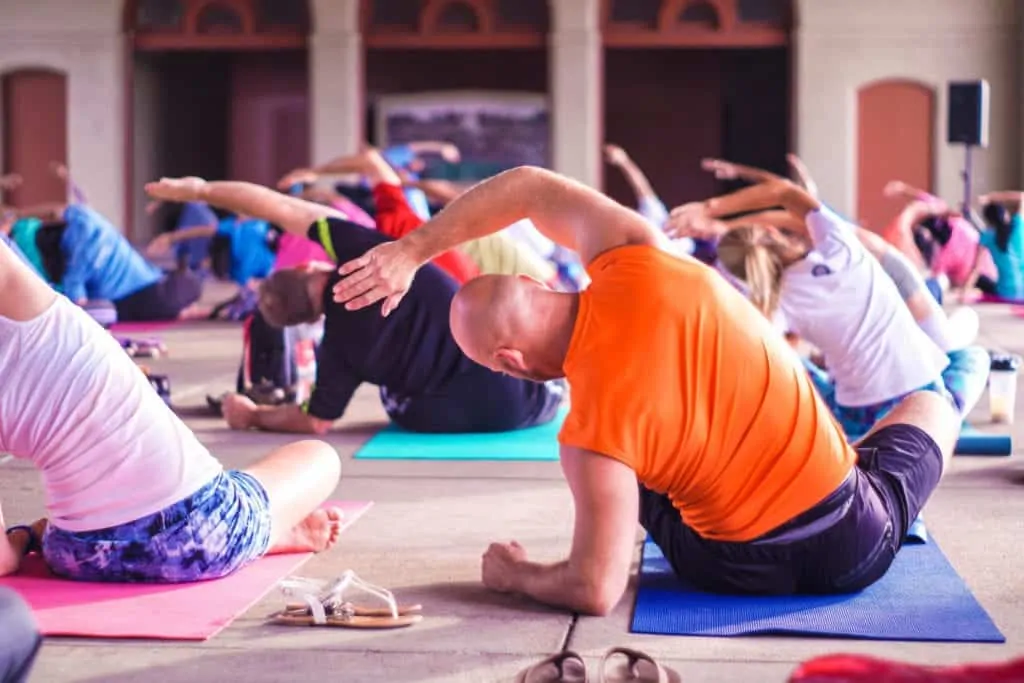Update (August 24, 2020): This post has been refreshed to reflect current research and to include additional information.
The most successful men in the world know how to build healthy habits. Think about it like this: Steph Curry takes 300 shots during the season, and up to 500 during the offseason. Why would Curry do something like this? Because repetition is the key to build healthy habits.
I consider myself to be a bit of a habitual habit breaker. When Rachel and I first met, I was obsessed with working out. Five to six days a week, I’d be in the gym powering through cardio, weight lifting, yoga—all of it. I looked at my body, and I was proud of my newly formed six-pack and pecs. I couldn’t wait for the summer to show off my new beach body.
And then I took a day off because I was tired. And another day because I had to stay late at work. And a week off because I wasn’t feeling well.
We know the rest of this story. I never ended up going back to the gym. I tried. Different gyms, different times of the day, different exercises. It didn’t matter, my male body image sank. Like most of my resolutions, I never built a sustainable healthy habit around going to the gym.
Sure, it’s August, we’re still in the middle of a pandemic and your New Year’s Resolution has gone to shit. That’s okay because I want to help show you how to build healthy habits that are going to last a lifetime, and not just a couple of months.
What’s the difference between creating a resolution and building a healthy habit?
According to the Cambridge dictionary, a New Year’s resolution is a promise to yourself to start doing “something good or stop doing something bad on the first day of the year.” Typically, these resolutions are at the macro-level, focusing on what you want to achieve by December 31 of next year. Examples of New Year’s resolutions might include “be less stressed,” “lose weight,” and “drink less alcohol.”
A habit, on the other hand, is “something that you do often or regularly, often without thinking about it.” Habits form on the micro-level; these are the day to day activities that you complete consistently. You probably already have plenty of small habits, like brushing your teeth, setting your alarm clock for a regular wakeup time, and charging your phone after work.
The New York Times reporter and author of The Power of Habit Charles Duhigg told the Harvard Business Review that “about 40% to 45% of what we do everyday sort of feels like a decision, but it’s actually habit.” It’s these small habits that continue to build on top of each other to help create a routine.
Success for any goal, regardless of if it’s a New Year’s resolution or not, is directly related to the habits we build throughout the year. Think of habits as the daily activities or building blocks, and the resolution as the macro-level result of putting all of those habits together.
New Year’s resolutions often fail, but not as often as we think.
An oft-quoted statistic is that 80% of New Year’s Resolutions fail before February, or that only 8% of New Year’s resolutions are successful—no actual research supports those claims. When reading through the research from 1988 that those figures are based on (I think it’s incredible that there wasn’t much that was more recent or relevant), the study actually found that of the 200 study participants, “77% maintained their primary New Year’s resolution for one week, 55% for one month, 40% for six months, and 19% for a full two years.” In other words, of those who make New Year’s resolutions, one in five succeed in their behavior change.
A second study published in 1972 found that dieters were far more likely to fail their New Year’s resolutions than non-dieters over the course of three months—in fact, most participants gained weight. Beyond dieting, however, these researchers found that resolution success rate was quite good—with a caveat. They write, “75% of these resolutions were reported as being kept over the three-month period. However, this figure is probably an exaggeration, as [participants] were asked to report on their own progress… Another difficulty concerns the degree of specificity in the initial resolution: overly general resolutions are more difficult to assess, compared to those which specified discrete targets of change. It is easier to report success in keeping a general resolution such as ‘becoming an all-round better person’ because of the lack of specified criteria.” The researchers doubt the claim of 75% success, and I think it’s safe to say the 1988 study confirmed that their findings were inaccurate.
So New Year’s resolutions aren’t entirely pointless—but few people actually achieve what they set out to do. Why are less than one in five resolvers successful? And what can we learn from those who successfully build lifelong habits?
Why do New Year’s resolutions fail?
The research shows that there are three main reasons for failing to accomplish our goals: they’re too ambitious, too abstract, and we lack a proper “why.”

1. The resolution is too ambitious
We love to dream big: the perfect body, the perfect diet, the perfect home. By imagining big, we look at the macro picture of what we desire and ignore the micro-practices that make accomplishing a resolution easier.
Psychology Today describes it as, “We try to eat the whole elephant.” Abstraction and ambition correlate as a reason why we fail our New Year’s resolutions. What that means is when you are setting your goal, phrases like “I am going to lose weight” or “I am going to spend more time with friends” are impossible because they are too large.
2. The resolution is too abstract
Immeasurable goals are impossible to achieve because they are just that: immeasurable. You need to be able to check out your progress over time and if your goal is too abstract, how will you know if you’ve actually reached your goal?
Changing habits isn’t easy and requires a ton of motivation, which is challenging to maintain over time. Jonathan Alpert told Business Insider, “It’s easier to drop out or walk away when you set goals or resolutions that are vague.”
3. The resolution doesn’t have a strong enough personal “why”
Why do we make New Year’s resolutions? Is it because of the holiday or the dream of being able to have a fresh start? Or is it because of the influence of our friends, family, and society?
One of the biggest reasons why people fail at their resolutions is because their goal isn’t personal enough. They haven’t hit a breaking point in their life that demands change; they’ve simply hit a new year, and because of that, they feel obligated to make a goal. There aren’t enough stakes to demand behavior change.
So then the questions become: what do you really want to change, and why? Just as importantly, why does that change have to be now? The inability to answer those questions may flag that you aren’t actually invested in your own goal.
5 essential steps to build healthy habits
The concept of the New Year’s resolution is that over the next year, you will strive to make a specific change. Focus on developing long-lasting habits that will be beneficial to the resolution itself. And as you continue working on those habits, you will constantly be moving towards your resolution. A resolution without a plan is a recipe for failure.
And sure, this all sounds great, but how do you build healthy habits?
Great question. Here’s my five-step formula on how to build healthy habits that will last a lifetime, all based on the science of goal setting and behavior change.

Step 1: Establish your “why”
Know what the key ingredient is to any behavior change is?
It’s not planning (though that helps).
It’s not having a team cheering for you (though that helps).
It’s not being in an environment that helps usher you along (though that helps).
It’s having the right motivation—the right “why” for what it is that you want to do.

Let me give you an example. John (a guy I just made up) didn’t like to exercise. He couldn’t remember the last time he went for a run, let alone picked up something heavy or got into a heavy sweat—he was the kind of guy who would prefer to be inside playing video games and petting his cat, MewMew, than heading out to a gym. One New Year’s Eve, he decided that he wanted to lose weight, so he proclaimed, “I’m going to lose 20 pounds this year.” The question then became “how?” John started his research.
John got overwhelmed. There were so many diets and exercises to choose from that he struggled to plan which ones to try. He would have liked to go to the gym, but he didn’t know how to use any of the equipment. Besides, moving made him feel overheated. He hated the feeling of sweat, let alone his heart racing or the thought of other people looking at him. He went to the gym twice, didn’t lose any weight, then decided that he’d try again the following year.
One day soon after, John came home to find his house on fire.
John ran inside. He didn’t think about how much he hated running.
John lifted debris off the floor. He didn’t care about how doing so made his muscles strain.
John rushed past his computer. His heart raced. He sweat. He didn’t care.
John found MewMew and scooped his kitty up into his arms. He sped outside. He didn’t notice that a crowd had gathered until he unwrapped MewMew from his arms. She was okay. He was okay too.
He didn’t even have a plan to do what he needed to do. John ran, lifted, sweat, and was observed as he exercised his whole body to save his cat.
Saving MewMew: now she’s motivation.
What’s your house that’s burning down? What MewMew do you need to save? Or conversely, what are you fed up with in your life? Where in your life do you—or your body, or your friends—deserve better?
Step 2: Adhere to the psychology of behavioral change
I’m a fan of Matt D’Avella—he’s a YouTuber who speaks on minimalism, productivity, and self improvement. In one of his episodes, he interviewed Nate Green, a well-respected fitness strategist, on why people fail at sticking to their habits. Green tells D’Avella, “The way that I look at behavioral change and turning action into knowledge is ‘What are the basics I need to know about this?’ ‘What are the skills I need to know?’ ‘How do I break those skills into smaller practices?’ And how do I make it so easy that it’s almost embarrassing, like anyone can do that.”
Let’s use a concrete example of starting a gym habit to break down what he means.
First, ask yourself, “What are the basics I need to know?” and, “What are the skills I need to know?”
To find your basics, start with some classic questions:
- Why are you invested in going to the gym? (You should have that answer already!)
- Who is going to the gym? (You! And maybe a friend.)
- Where should you buy a gym membership? (I like this ten-point checklist from Huffington Post.)
- How much does that membership cost? (Investing in yourself is always the best investment.)
- When can you go? (Everyone has peak hours when they’re most likely to accomplish their challenging tasks.)
- What will you do when you get there? (Just download a free beginner’s fitness app—here’s a list of five to get you started.)
Remember: the internet isn’t your only source of research. Ask someone who is already succeeding at the habit you want to establish for yourself to help you get started—they know way more about finding what might work or not than you could from reading an article. To keep the example above going, that’s the value of a fitness trainer.
No one in your life that can help you? No problem. Figuring it out on your own is just as viable a solution—the excuse to not invest in your goals because of the absence of a mentor is just that: an excuse.
You’ve built up the basics and you know the skills you need. Now you need to break everything down into tiny, stupidly easy morsels. And by “stupidly easy,” I mean you should feel like you’re rolling your eyes and thinking to yourself, “Anyone can do that, especially me.”
For example, Green asks his fitness clients, “How likely are you to go to the gym three times a week?” on a scale of one to ten. If they say anything less than a seven, Green then asks, “How about two times?” And if that’s still around a seven, Green finally says “Let’s do one time a week.” Anyone can commit to going to the gym once a week. For an hour? For thirty minutes? For twenty? Pick a starting point that’s embarrassingly easy and commit to it for 10 weeks—according to research on habit formation, conscious action turns into a habit after 66 days on average (though for some people, it can take as little as 18 days!).
Step 3: Build your new healthy habit with a formal commitment

There are two easy ways to set yourself up for success:
- Create a conducive environment for success
- Schedule, schedule, schedule
Simply put, plan ahead.
Planning a habit-focused environment
Your goal for your environment, meaning all the people, spaces, and digital noise, is to eliminate all the steps that hinder you from completing your goal.
Think about the physical objects you might need and organize them for easy access before starting your habit. For example, if you’re going to hit the gym in the morning, pull out your gym clothes and shoes the night before so you’re not letting your mind wander to where they might be in the morning, lulling you back to sleep.
Think back to your why: is there anyone who will benefit from you achieving your goal? Or will someone suffer if you don’t? Tell that person who has a stake in your success about your new habit. Tell them, vulnerably, that you’re working to establish a new habit. Say you’ll send them note every time you complete it in your first month. They’ll not only appreciate it, but encourage you to keep going. Their investment in you will help spur your motivation when you can’t muster a reason to complete your habit for yourself.
Schedule your success
You need to prioritize your habits to succeed. That means scheduling activities and holding yourself accountable for completing them.
Use a calendar to block out time for your habit. Set a bunch of alarms on your smartphone to remind you to get going. Your habit can only slip your mind if you haven’t prepared for it.
Another way to schedule your success is by batch processing your energy-draining activities. With your free-time, batch as many tasks together to increase the amount of focus you’ll have for more time-consuming tasks later in the week.
Keep track of all of the small decisions you make throughout the day and week, and try to figure out which choices could be made ahead of time. It’s the same concept Matilda Kahl, Mark Zuckerburg, and Barack Obama use for deciding what clothes to wear—successful people tend to wear the same outfits over and over again.
Why?
Because by not having to stress over your outfit, you’re allowing yourself more brainpower to focus on other activities. Fully focus on establishing your new habit and get rid of time spent on elsewhere if you can. In other words, optimize your brainpower for your habit, especially in the first ten weeks. After that, your habit will take care of itself.
Step 4: Prioritize consistency
Life always finds a way to get in the way of you accomplishing your goals. Maybe you’ve been feeling sick, or you missed a day on your schedule. You need to accept that at some point, you will screw up, and that is okay.
Remember: perfection is not the goal, but consistency is.
So if you miss a day of your habit, what’s most important is that the next day, you get back to it the next. Never miss a day for your habit twice in a row because quickly, that one day turns into two turns into a week. James Clear emphasizes “repetition over perfection” and suggests that you plan for failure. He gives an example about a weight-loss coach who “doesn’t bother with daily calories.” Instead, he looks at weekly calorie totals to make sure his clients are headed in the right direction. Clear writes, “He is not concerned if you make a mistake or binge eat once or twice. He realizes that individual meals don’t matter if you maintain the right ‘average speed’ over the course of the week.” In other words, focus on your equivalent “average speed” over any day-to-day failures. One day missed is not the same as a week, a month, or a lifetime.
Think about upcoming events or trips on your schedule. Maybe there’s a holiday coming up. It doesn’t matter what it is, take a look and see how you might be able to work around the event and how you plan to get back on track if you do mess up. Normally, there’s no special planning other than a commitment to yourself that you’ll get back to it the following day.
No problem. You can do that.
Step 5: Honor the time it takes to achieve big things
The most coveted personal achievements in life always take time.
Get a six pack.
Write a book.
Learn to code.
None of those things happen in a day. My bet is that the things you really want from your new habits are big, seemingly unachievable goals. Goal setters are go-getters. Going slow and seeing only marginal weekly progress can certainly be discouraging.
But remember: Day 365 always with Day 1. And then Day 2. And then Day 3. Change takes time.
By setting more straightforward, smaller goals at the start, you will feel more accomplished, and that self-confidence will continue to motivate you. Something as small as a penny doubled in value every day over the course of a month is worth $5,368,709.12. In other words, your efforts will compound, but you must start somewhere.
Green explained in his interview, “Are you consistently going to the gym and doing this one workout, one day per week? And it seems like such a small change, but for someone who has never worked out before, if they consistently go to the gym one day a week, that’s 52 workouts in a year, when they may have done zero beforehand.” Smaller steps looked at over the long term will help motivate and push you towards pursuing your goals over the course of a year.
Ready to get started?
If you still don’t know how to get started, check out the worksheet. It’ll take you less than ten minutes and the you in 365 days will thank the you of today for committing to your new habit right now.


2 Responses
This was great. So much information here and it makes so much sense. So many people are writing either what their goals are or why resolutions aren’t worth the time. This is a much better angle! I will definitely be adopting some of these ideas. I love the idea of finding the why
Hey Emma,
I wish you the best of luck on your habit-building journey!
Thanks,
Garrett